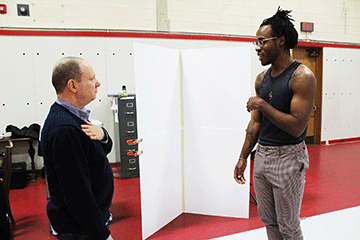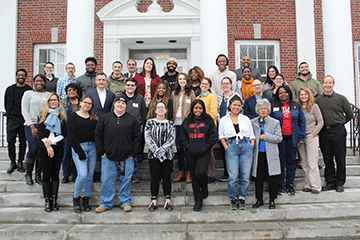
03/10/2020
On any given day, there are roughly 8,400 different individuals working, learning and interacting on the SUNY Cortland campus. They come from different countries, different communities, different cultures and different ethnic backgrounds. Some grew up in poverty, others are from wealthy families. They practice different religions, espouse different politics, identify with different genders and sexual orientations and have incredibly diverse interests and passions.
But, as human beings, they also have lots in common.
A new campus project seeks to underscore that humanity by exploring the unique stories and individual identities of 25 members of the SUNY Cortland community in a series of artistic posters.
The Beloved Community Diversity Narratives Project at SUNY Cortland aims to visually share the essential life stories of students, faculty and staff members and alumni with campus and community.
“Honestly, I’m a storyteller, and so for me, every story is a compelling story, because it belongs to a human heart,” said visiting artist Adam Mastoon of Adam Mastoon Transmedia, pausing from photographing campus employee Cyrenius Nelson ’19 at his large, temporary studio in Van Hoesen Hall.
Mastoon most recently visited campus in early February to meet and talk with 25 diverse individuals who volunteered for the project about their unique stories. Each participated in a writing workshop about their personal histories, and all were photographed over the course of three days this week with the idea of creating a piece of public art grounded in the narratives.
“We wanted to develop a project that would not only be a conversation starter, but would passively and actively promote an inclusive environment for faculty, staff and students,” said James Felton, vice president for equity and inclusion at The University of New Jersey. He served until recently as SUNY Cortland’s former chief diversity officer.
The results will appear around campus as print posters of various sizes and shared as digital images on the university’s website, a blog and SUNY Cortland’s social media channels. During his visit, Mastoon walked the campus with facilities management officials to consider how best to display the finished pieces.
Mastoon’s project is part of the university’s ongoing effort to make SUNY Cortland as inclusive and welcoming a community as possible to people from increasingly diverse backgrounds and identities.
The project’s name comes from a quote by the Rev. Martin Luther King Jr. that reflects the spirit of the initiative: “Our goal is to create a beloved community, and this will require a qualitative change in our souls as well as a quantitative change in our lives.”
Mastoon was excited to work with the 25 different people whose applications were accepted for the project.
“So even the smallest details can be, and are, compelling: the way a light hits someone’s face, the way a curl comes across the forehead,” said Mastoon, the founder of The Shared Hearts Initiative, a non-profit organization that created an exhibition and school curriculum to amplify authentic, life-affirming stories of LGBT youth.
“The visual details and the personal narratives are compelling,” said Mastoon.
Each poster will tell its own story. Together the pieces can serve to deepen the conversations about diversity, inclusion and equality in communities nationwide.
“His work makes you want to stop and pay attention to the people and the stories he’s captured in his portraits,” Felton said. “Adam’s work reflects the type of community we wanted to reflect on campus.”
Mastoon only completes about three campus projects a year because each takes about six months of work.
Mastoon, of Barrington, Rhode Island, describes himself as a socially engaged artist, author and educator driven by a desire to create work that addresses equity, inclusion and social justice. He collaborates with communities nationwide to develop distinctive storytelling projects that engender empathy and connection.
“I feel very happy because I feel the spark of the person in the images,” said Mastoon. “That is my sacred task, to be able to stand in front of somebody and to be able to reflect themselves back so that the world can see them. I feel I accomplished that with Cyrenius (Nelson) and so I feel grateful and happy.”
Nelson, who hails from Staten Island, N.Y., and directs one of SUNY Cortland’s 16 residence halls, graduated in 2019 from Cortland and enjoys writing poems, drawing and doing puzzles. Earlier Mastoon had photographed Regina Grantham, associate professor of sciences and disorders.
“She has an incredible story to tell,” Mastoon said. “She shared with me her path and her love, being an educator. To be able to hear that and see that and reflect that back into this community, really, is a gift.”
Mastoon studies each participant’s personal written narrative as a way to know each individual for the sake of telling their story. The 25 photo subjects will have an opportunity to fine-tune and edit their writing to later become part of the eventual poster.
Mastoon’s project team encompasses a lot more than the two photographers who traveled with him to campus and the graphic design team back home.
“It’s important to say this is a ‘we’ project,” Mastoon said.
“There are 12 people on the committee that helped to make this happen. There is James Felton who is the keystone of this project and who was the spark of making it happen. There was the vision of President (Erik J.) Bitterbaum, who could see how this could make a difference on the campus. All of us together, along with the 25 people who are courageously coming forward, are the team that are making this happen.”
Since 2010, Mastoon, recipient of the American Library Association’s Gay and Lesbian, Non-Fiction Book Award, has worked in academic communities making portraits and inviting people to share their personal stories in words and pictures.
Mastoon has captured the essence of 300 individuals to date in versions of the project at Georgia Institute of Technology, Swarthmore College, Rhode Island School of Design, Babson College and Washington State University. Examples can be found on Mastoon’s community narratives web page.
The Cortland campus will soon add their stories to the mix.
“I am meeting a group of people who want to celebrate their uniqueness, and I’m here being welcomed by a community that believes in the importance of that idea,” Mastoon said of Cortland. “Because of that, I experience Cortland as a really open and positive and affirming community.”
Felton said the project originated with his office and Nicole Basile ’19, the former Student Government Association director of diversity, equity and inclusion.
In order for SUNY Cortland to give new students the tools they need to thrive and graduate despite being in an unfamiliar environment that may seem hostile, the university’s administration has to listen closely to those who are already here, he said.

For that reason, the university also is taking many steps to reach out to the entire campus community, including the part of the university’s population that identifies itself as ethnically or racially diverse, approximately 26% of the student body.
A voluntary anonymous online campus inclusion survey has been underway since the fall to assess how welcoming SUNY Cortland is to all students, faculty and staff. A SUNY Cortland Campus Climate on Diversity Committee asked students to express their opinion on the quality of college life for them with respect to four major themes: race; gender, gender expression or sexual orientation; dis(ability); and religion and spirituality, during Spring 2019. Based on those responses, the group developed the survey questions and began administering the survey in the fall. The survey also asks respondents to offer their insight on what the institution might do to nurture a better learning and working environment at Cortland.
SUNY Cortland expects to release survey findings later this spring.